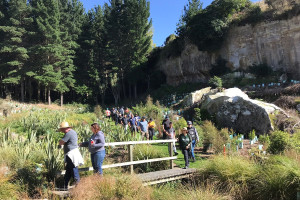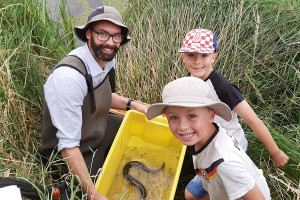Ōrāri Temuka Ōpihi Pareora Water Zone Committee Action Plan 2021-2024
Each of Waitaha/Canterbury’s water zone committees has an action plan which outlines how they will work with the community to deliver their aspirations for freshwater as outlined in the Canterbury Water Management Strategy (CWMS).
The CWMS puts the future of our water resources in the hands of the community. Zone committees work collaboratively to develop recommendations for councils and other organisations to deliver shared goals and targets.
Committee purpose
To uphold the mana of the freshwater bodies within OTOP by facilitating enduring land and water management solutions that give effect to the Canterbury Water Management Strategy (CWMS) vision, principles and targets in our zone.
The CWMS aims to enable present and future generations to gain the greatest social, economic, recreational and cultural benefits from our water resources within an environmentally sustainable framework.
Committee role
- To get involved in an active programme of community engagement on freshwater management matters.
- To facilitate relevant advice to councils and other organisations contributing to freshwater management.
- To extend the resources available to implement the CWMS by: working with stakeholders across all sectors and seeking opportunities to promote, support, leverage and expand catchment-based initiatives that deliver the CWMS.
- To report back annually to councils and Rūnanga on progress towards delivery of the zone-specific priorities.

The committee has a focus on tuhituhi o neherā/rock art sites

Protecting and enhancing mahinga kai is a priority
Our actions
Find out more about how we're tracking to achieve our goals and what progress has been made in the last year.
View the 2021/22 progress report.
Our vision:
Te Mana o te Wai - When managing freshwater, it ensures the health and well-being of the water is protected and human health needs are provided for before enabling other uses of water - for us and our children after us.
CWMS – To enable present and future generations to gain the greatest social, economic, recreational and cultural benefits from our water resources within an environmentally sustainable framework. The first order priorities are environment, customary use, community supplies and stock water.
We commit to assist with the protection, enhancement and restoration of mahinga kai (to work the food – gather, harvest, preserve, conserve) and tuhituhi o neherā (rock art or rock drawings) sites:
- Facilitate a session for members of the public at the Te Ana Māori Rock Art Centre and host a field trip to Taniwha Gully with invited catchment group members.
- Focus on tuhituhi o neherā sites and mahinga kai and how best to manage these.
We commit to providing opportunities to engage and collaborate with Rūnanga (tribal councils or tribal iwi/authorities):
- Host an annual Te Tiriti o Waitangi workshop for community members to attend.
- Work with Papatipu Rūnanga (Ngāi Tahu regional tribal councils) and relevant landowners to host at least one hīkoi (involves a walk across the local area to understand the flora and fauna, taonga or treasured species and culturally significant sites) for the community. Areas of interest include Waitarakao Washdyke Lagoon, Te Ahi Tarakihi Reserve and Creek, Milford Lagoon, Rakitata restoration and Arowhenua Nursery.
We commit to raising understanding of te mana o Te Mana o Te Wai me Te Mana o Ngā Awa (the importance of water and the importance of our waterways) in a rural, urban, and industrial context:
- Host a public forum, combined with other Southern Canterbury zone committees, to assist the public in understanding what te mana o te wai me te mana o te awa means for them.
- Request six monthly briefings from Environment Canterbury on the state of our water resources from each catchment and results from monitoring and share with relevant catchments.
We champion safe and reliable drinking water for the OTOP community:
- Host at least one community session offering on-site indicative private drinking water testing. Include presentations of possible solutions and research on reducing high nutrient and contaminant concentrations.
We engage with the community and raise awareness of the impacts of human activity on land and water:
- Supporting and engaging with the Catchment Collective South Canterbury Society Incorporated (CCSC).
- Zone committee members to be a member of a catchment group(s) where appropriate.
- Seek reports from CCSC Chair and / or catchment groups for OTOP meetings.
- Bi-monthly media presence (e.g The Courier) and engagement through official local council channels.
- Have a physical presence, at least twice a year, at key public events (e.g Geraldine Fete, Farmers Markets etc).
- Promote OTOP zone activities via dedicated zone links on local council websites.
Council priorities
Zone committees are joint committees of local and regional councils, with mana whenua and community representation. Councils provide CWMS priorities for each zone committee to guide the committee’s action plans.
Waimate District Council priorities
- Safe drinking water free of contaminants for humans and animals;
- Rivers and wetlands have healthy ecological flows and high-quality water;
- Rural and urban communities are fully engaged and have ownership of water management processes;
- Native and indigenous wildlife associated with waterways have adequate habitats.
Mackenzie District Council priorities
- Support catchment groups;
- Drinking water supplies (awareness and education);
- Recognise and protect culturally significant sites;
- Protect and enhance mahinga kai; and
- Protect and enhance biodiversity
Timaru District Council priorities
- Lowland stream health – collaborate to reduce ecological damage to stream health from sediment and contaminants from stormwater and wastewater. Community education/behaviour change campaigns on stormwater issues and management;
- Indigenous biodiversity – advocate for indigenous biodiversity. Education/behaviour change campaigns to improve understanding of the importance of protecting and conserving indigenous vegetation as well as the management of Significant Natural Areas;
- Safe drinking water – collaborate to ensure Drinking-water standards for New Zealand are met. Education on land-use activities within drinking water protection zones;
- Water use management and conservation – community education/behaviour change campaigns on water use management and conservation.
Environment Canterbury priorities
Kaitiakitanga Wāhi Taonga and mahinga kai targets
- Grow support and resources to achieve the goal of five mahinga kai projects.
Ecosystem health and biodiversity targets
- Increased riparian management to protect aquatic ecosystems.
- Reducing the number of fish barriers.
- Protection and enhancement of wetlands.
Recreation and amenity targets
- Achieving the 2025 target to restore priority freshwater recreation opportunities in each zone.
